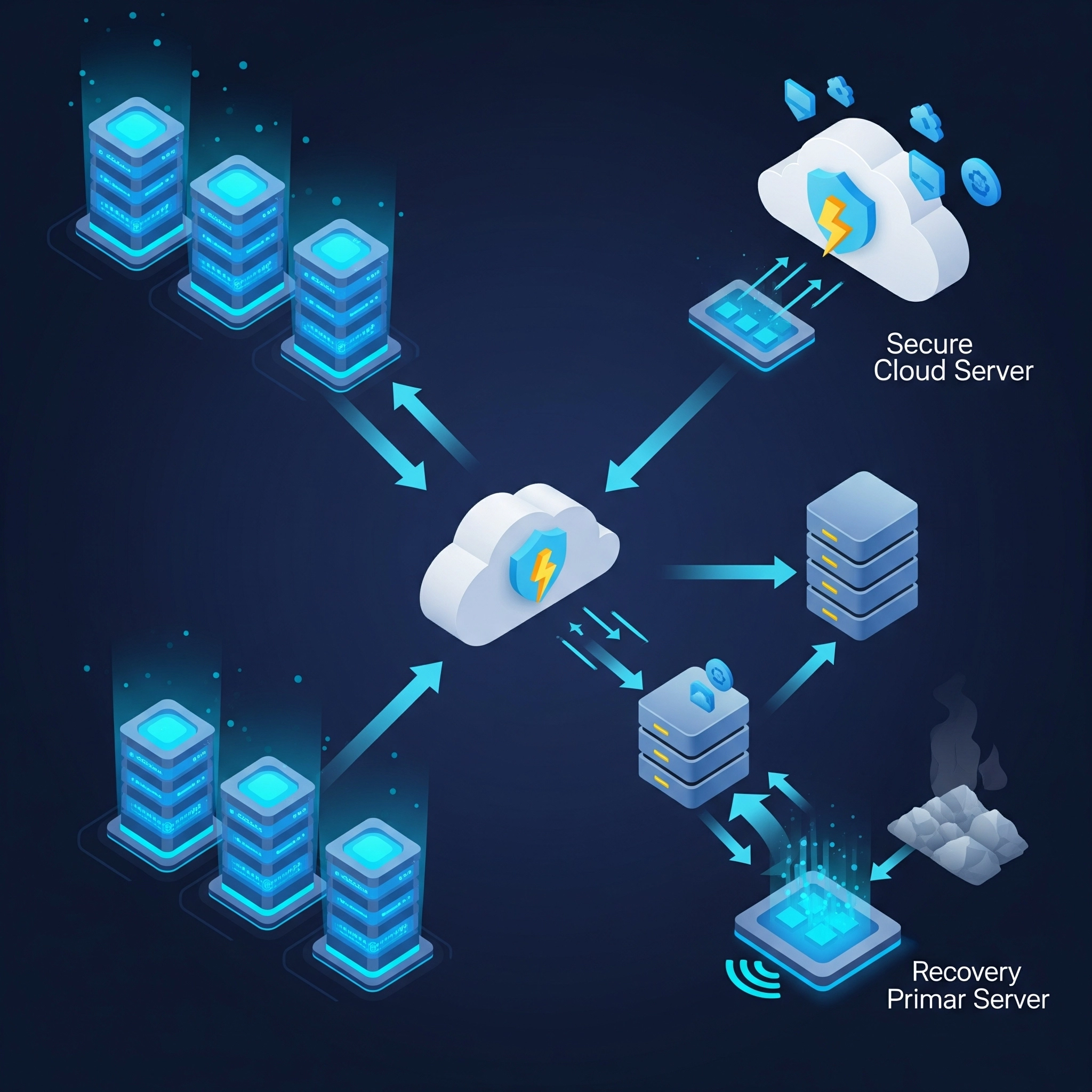Data Backup and Disaster Recovery
Introduction:
For any website, regardless of its size or purpose, Data Backup and Disaster Recovery are paramount. They are two distinct but intrinsically linked concepts that form the backbone of a robust business continuity strategy.
What is Data Backup?
Data backup is the process of creating copies of your website`s data and storing them in a separate, secure location. The primary goal of backup is to ensure that if the original data is lost, corrupted, or becomes unavailable due to various incidents, you have a replica to restore from.
What to back up for a website typically includes:
- Website Files:
- Core CMS files: If you use a Content Management System like WordPress, Joomla, or Drupal, these are the fundamental files that make up the system itself.
- Theme and Plugin files: These customize the appearance and functionality of your website.
- Uploaded media: Images, videos, documents, and other files uploaded by you or your users.
- Custom code: Any custom HTML, CSS, JavaScript, or other programming files.
- .htaccess and other configuration files: These control server behavior and website settings.
- Database: This is arguably the most critical component, especially for dynamic websites (e.g., e-commerce, blogs, forums). Your database stores all your content, user information, product details, comments, and much more. Without it, your website is essentially an empty shell.
- Server Configurations (if applicable): For dedicated servers or VPS, backing up server configurations (e.g., Apache/Nginx settings, PHP configurations) can significantly speed up recovery.
Common Backup Strategies:
- Full Backup: A complete copy of all selected data. While comprehensive, it`s time-consuming and requires significant storage.
- Incremental Backup: Only backs up data that has changed since the last backup (full or incremental). This saves time and storage but can be complex to restore, as it requires the full backup and all subsequent incremental backups in sequence.
- Differential Backup: Backs up all data that has changed since the last full backup. This is a middle ground between full and incremental, offering faster restores than incremental but consuming more storage.
- Mirror Backup: Replicates source data in real-time, offering an up-to-date copy. While good for immediate recovery, it doesn`t offer versioning and can replicate corrupted data if the source is compromised.
The 3-2-1 Backup Rule (a widely recommended best practice):
- 3 copies of your data: Keep the original and at least two backup copies.
- 2 different storage types: Store your backups on two different types of media (e.g., external hard drive and cloud storage, or two different cloud providers).
- 1 copy off-site: Keep at least one backup copy in a geographically separate location to protect against local disasters (fire, flood, theft at your primary location).
What is Disaster Recovery?
Disaster recovery (DR) is a comprehensive plan and set of processes designed to quickly restore access to your website, applications, data, and IT resources after a disruptive event (a "disaster"). While backup is about having the copies, disaster recovery is about using those copies to get back online and operational.
Types of Disasters a Website Can Face:
- Cyberattacks: Ransomware, malware, DDoS attacks, data breaches, website defacement.
- Hardware Failures: Server crashes, disk failures, network equipment malfunctions at your hosting provider.
- Software Corruption: Bugs in CMS, plugins, themes, or database corruption.
- Human Error: Accidental deletion of files, incorrect configurations, botched updates.
- Natural Disasters: Floods, fires, earthquakes, power outages affecting your data center.
- Hosting Provider Issues: Outages, technical problems, or even the provider going out of business.
Key Concepts in Disaster Recovery:
- Recovery Time Objective (RTO): The maximum acceptable downtime for your website after a disaster. A lower RTO means a faster recovery and usually higher costs.
- Recovery Point Objective (RPO): The maximum amount of data you can afford to lose after a disaster. A lower RPO means more frequent backups and typically higher costs.
- Failover: The process of automatically switching from a primary system to a backup system in a way that is seamless to users, minimizing downtime.
- Failback: The process of switching back to the original primary systems once the disaster has passed and they are fully restored.
- Restoration: The process of transferring backup data back to your primary system or a new system to bring it online.
Why are Data Backup and Disaster Recovery Crucial for Your Website?
- Business Continuity: Ensures your website remains accessible and functional, minimizing disruption to your operations, sales, and customer service.
- Data Integrity and Availability: Protects against data loss and corruption, ensuring your valuable information is always available.
- Reputation Protection: Downtime or data loss can severely damage your brand reputation and erode customer trust. A quick recovery demonstrates reliability.
- Financial Loss Prevention: Every minute of downtime for an e-commerce site or a business-critical web application can translate to significant revenue loss.
- Compliance: Many industries have regulatory requirements for data protection and retention, which robust backup and DR strategies help meet.
- Peace of Mind: Knowing you have a plan and the ability to recover provides immense peace of mind.
Developing a Data Backup and Disaster Recovery Plan for Your Website
Creating a comprehensive plan involves several critical steps:
Phase 1: Assessment and Planning
- Identify Critical Data and Systems:
- What are the most important components of your website (database, specific files, applications)?
- What data changes most frequently?
- Which parts of your website are "mission-critical" (must be restored immediately), "essential" (can be down for a few hours), or "non-essential" (can wait longer)?
- Define RTO and RPO: Based on the criticality of your website and its components, determine how much downtime and data loss are acceptable. This will dictate your backup frequency and recovery speed requirements.
- Conduct a Risk Assessment: Identify potential threats (cyberattacks, hardware failures, human error, natural disasters) and their likelihood and potential impact.
- Inventory Your Infrastructure: Document all hardware, software, applications, and network components involved in your website`s operation. Include their dependencies.
- Assign Roles and Responsibilities: Establish a clear disaster recovery team with defined roles for each member during an incident.
Phase 2: Implementation of Backup Solutions
- Choose Backup Methods:
- Automated Backups: Most hosting providers offer some form of automated daily or weekly backups. While convenient, rely on these as one of your backup copies, not your only one.
- Website/CMS Plugins: Many CMS platforms (like WordPress) have plugins that can automate backups of your files and database to various destinations (cloud storage, FTP).
- Manual Backups: Regularly download your website files via FTP/SFTP and export your database via phpMyAdmin or command-line tools. This is a good supplemental method.
- Dedicated Backup Services/Software: Third-party services or software solutions specifically designed for website backup and DR (e.g., specialized plugins, cloud backup providers).
- Select Storage Locations:
- Cloud Storage: Highly recommended for off-site storage. Providers like Google Cloud Storage, AWS S3, Dropbox, OneDrive, Backblaze, etc., offer scalable and secure options.
- External Hard Drives: Good for local, off-site copies (e.g., store one at home, one at the office). Ensure they are physically secure.
- Network Attached Storage (NAS): Can be used for on-premise storage with redundancy.
- Remote Servers (FTP/SFTP): Store backups on a different server than your live website.
- Schedule Backups: Based on your RPO, set a regular schedule for backups.
- Highly dynamic sites (e-commerce, news): Daily or even hourly backups.
- Less dynamic sites (static brochures, personal blogs): Weekly or monthly backups.
- Always perform a backup before any major website updates, theme/plugin changes, or migrations.
- Encrypt and Secure Backups: Ensure your backup data is encrypted both in transit and at rest. Secure access credentials to your backup storage.
Phase 3: Developing the Disaster Recovery Plan (The Playbook)
- Document the Process: Create step-by-step instructions for what to do in various disaster scenarios. This should be a clear, concise "runbook" that anyone on your team can follow.
- Initial Response and Communication Plan:
- How will you detect a disaster?
- Who needs to be notified (team, customers, stakeholders)?
- What are the communication channels (email, SMS, alternative website)?
- Recovery Procedures (for different scenarios):
- Database Restoration: Steps to restore your database from a backup.
- File Restoration: Steps to restore website files.
- Application/CMS Restoration: How to get your CMS and its components back online.
- Server Recovery (if applicable): Steps to rebuild or restore a server.
- Failover Procedures: If you have redundant systems, how do you switch to the backup?
- Data Synchronization: How to ensure data consistency if using replication.
- Hardware/Software Requirements: List all necessary software licenses, hardware specifications, and tools required for recovery.
- Contact Information: Maintain an up-to-date list of key personnel, hosting support, plugin/theme developers, and other relevant contacts.
- Off-network Storage of the Plan: Store a copy of your DR plan both digitally (e.g., in a secure cloud drive, encrypted USB) and physically (printed copy) in a location separate from your primary IT infrastructure, in case your network is compromised or inaccessible.
Phase 4: Testing and Maintenance
- Regular Testing: This is the most crucial step. A plan is useless if it hasn`t been tested.
- Tabletop Exercises: Discuss scenarios with your team to identify gaps in the plan.
- Partial Recovery Tests: Test restoring specific components (e.g., just the database, or a single directory).
- Full Recovery Simulations: Periodically (e.g., annually) simulate a complete disaster and attempt to restore your entire website from scratch in a test environment. This helps identify unforeseen challenges.
- Test Environment: Always test restores in a separate, isolated environment to avoid impacting your live website.
- Review and Update:
- After every test, review what worked and what didn`t. Update your plan accordingly.
- Regularly review the plan (at least annually) to reflect changes in your website, infrastructure, software versions, and potential threats.
- Ensure all team members are familiar with the updated plan.
Choosing Solutions: Cloud vs. On-Premise
- Cloud Backup & DR Solutions:
- Advantages: Scalability, geographic redundancy, often managed by the provider, lower upfront capital investment, accessibility from anywhere.
- Disadvantages: Reliance on internet connectivity, potential data sovereignty concerns, recurring costs can add up.
- Examples: AWS Backup, Google Cloud Storage, Backblaze, Acronis, Carbonite, specialized website backup services (e.g., VaultPress for WordPress).
- On-Premise Backup & DR Solutions:
- Advantages: Full control over your data, potentially faster local restores, can be more cost-effective for very large datasets if you already have the infrastructure.
- Disadvantages: Requires significant upfront investment in hardware and software, ongoing maintenance and management, vulnerability to local disasters, limited scalability, requires dedicated IT staff.
- Examples: External hard drives, Network Attached Storage (NAS), tape drives, local backup software.
- Hybrid Approach: Combining both cloud and on-premise solutions for a balanced approach to security, speed, and redundancy (e.g., local backups for quick restores, cloud backups for off-site disaster recovery).
Cost Considerations
The cost of data backup and disaster recovery varies widely depending on:
- Website Size and Complexity: Larger websites with more data and dynamic content require more storage and more frequent backups, increasing costs.
- RTO/RPO Requirements: Lower RTOs and RPOs (faster recovery, less data loss) generally require more expensive solutions (e.g., real-time replication, dedicated DR sites).
- Chosen Solutions: Cloud services are often subscription-based, while on-premise solutions involve upfront hardware costs and ongoing maintenance.
- Managed Services: Engaging a third-party to manage your backup and DR will add to the cost but can provide expertise and reduce internal workload.
Conclusion
Data Backup and Disaster Recovery are not optional for a serious website; they are foundational pillars of its long-term success. By investing time and resources into a well-thought-out and regularly tested backup and DR plan, you protect your digital assets, ensure business continuity, and safeguard your reputation against the inevitable disruptions that can occur in the digital landscape. Remember, it`s not a matter of if a disaster will strike, but when. Being prepared is your best defense.
.webp)







 Call Now
Call Now

